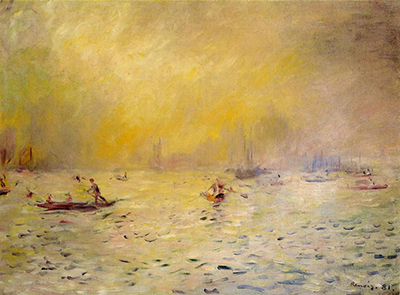View of Venice Fog, produced in 1881, is an oil-on-canvas painting that was created by Pierre-Auguste Renoir during a turning point in his career
The landscape painting, executed in the same year that the French artist visited Italy, depicts a portion of the city’s skyline from the perspective of the Venetian Lagoon. Fog, a common sight along the northern coast of the Adriatic Sea, looms on the horizon and obscures a domed building on the left-hand side of the canvas.
Small boats, forming the principle mode of transport in the City of Canals, are seen navigating the lagoon and those vessels that appear further into the distance are also shrouded by fog.
Venice, subject to a humid subtropical climate, is most likely to experience fog between the months of November and April. Renoir, observing the spectacle from a boat in the lagoon, used broad brush strokes to capture the slow movement of the vapour as it drifts into the city from the nearby sea.
Wisps of yellow fog, located at the centre and right-hand side of the painting, appear beneath a lighter patch of sky where sunlight shines through the low clouds. The fog in the background, painted in various shades of blue and purple, contrasts with the yellow hues of the fog patches in the foreground of the artwork.
Renoir paints the calm waters of the lagoon, residing between the mouths of the Po and Piave rivers, with a base colour of pale blue and creates the impression of shallow waves with bold lines of darker blue and green. The bottom-right of the canvas contains the highest concentration of superficial brush strokes, signifying an increase in surface movement and underwater current in that portion of the lagoon, while the yellow patches of fog in the distance are reflected in the water below.
The artist's other paintings of Venice, although viewed from the perspective of the water, differed from this masterpiece in that they depicted the city in clear weather and with blue skies in the background.
Transportation in 1880s Venice, despite a railway connection with the mainland that was formed in the 1860s, still depended on its waterways and the boats that navigated the city's canals and surrounding waters performed a similar task to the horses and carts in mainland cities.
Renoir, looking at the old city near the entrance of the Grand Canal, portrays two gondolas in the middle-distance and a number of sailing vessels in the background. The masts of the distant sailing boats, too large to navigate the shallow waters of the Grand Canal, appear to merge with the structures along the shoreline.
Santa Maria della Salute, a seventeenth century basilica that was built to commemorate the 1629-31 plague that killed a third of Venice’s inhabitants, is the main architectural landmark visible in the painting and one of the most recognisable features of the city’s skyline from the lagoon. The painting, located in the Kreeger Museum in Washington DC, is one of several that resulted from Renoir’s Italian expedition that depicts one or more of Venice’s famous buildings.




